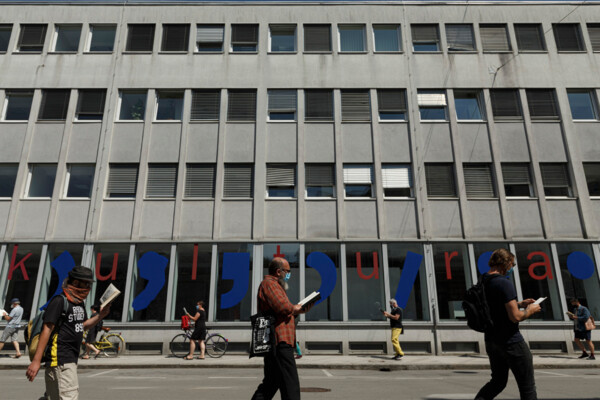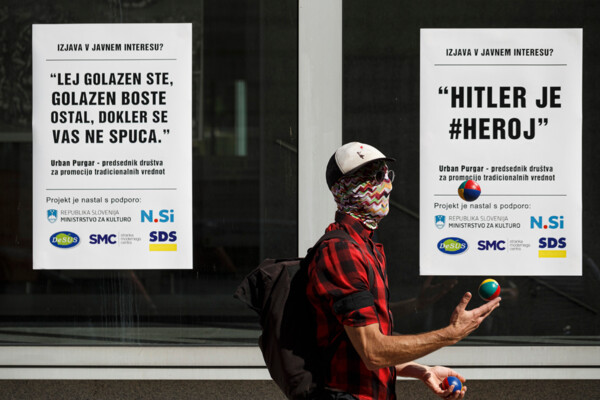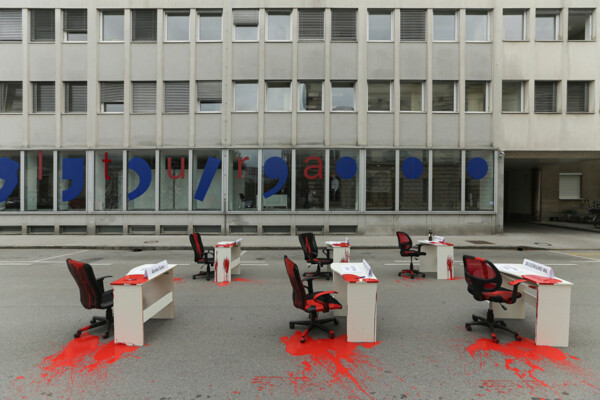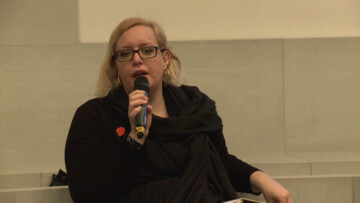Any kind of subversive action, be that on the terrain of social movements, or radically engaged art, is subjected to the constant potentiality of recuperation. In this context we understand recuperation as a social activity, used for maintaining control over those who are trying to negate it.
Recuperation comes in many forms: as an open repression by the state, as the politics of integration into the system (like elections and adaptation of the protest discourse into the mainstream), and sometimes even by internalised censorship of the most subversive ideas. No matter the method, or source, the result is always the same. Instead of widening the field of possibilities in terms of spreading the horizon of a subversive political action, it narrows the political → territory to the redefinition of the status quo. In it power relations more or less remain unchallenged. In the framework of social movements, recuperation is always a methodology of the defeat of a particular outburst of anger, and the beginning of a neutralisation of the movement itself.
The only tactics that are constantly proving to be resilient towards such power of political neutralisation are creative direct actions that are in their practical manifestation questioning and pushing the boundaries of the existing, are too subversive to be publicly claimed, and are creating a new political terrain that cannot be addressed through politics of structural and systemic ignorance of the raised issues.
Direct action is often publicly seen as the most militant expression of anger (that is, destruction of private property), and as such recognised by the ruling classes as one of the violent and undesired elements of protests. This language of power is often also repeated among some of the protesters themselves. Research into the concrete practices of direct action shows that violence is a changeable category, and its definition depends on the amount of concentrated power one has in society. Throughout history, different art practices challenged those definitions and power relations through direct action, thus broadening the window of opportunity for a radical transformation of society as a whole. Let’s look at the example of a recent decade in Slovenia.
Politics of recuperation: protest, conflict and culture
The transition from socialist Yugoslavia towards more or less violent integration into Western neoliberal market-capitalism was marked in Slovenia by waves of protests and autonomous social movements in the 1980s. Those roaring eighties brought out LGBT, → feminist, anti-war, → ecological and other social movements. Artists, ranging from underground punk to neo-avantgarde practices, had always been travelling with or indeed were the fundamental part of those movements. With the outbreak of war that led to the violent disintegration of Yugoslavia, most of these movements and artists either formed the newly born non-governmental sector (as a response to and critique of the institutions) while a minority stayed within the framework of autonomous spaces and movements. The latter movement culminated in the squatting of infrastructure throughout the country (most famously at Pekarna in Maribor and Metelkova in Ljubljana, but also in many other places). These squats proved to be fundamental for the subversive organising of social movements from that point on.
With the proliferation of precarity and the Western model of project financing eating away workers’ rights within the art scene, many people became politicised during various outbursts of social dissatisfaction. The culmination of this trend occurred in 2012 and 2013 with a six-month uprising that, among other things, toppled the far-right government. At the beginning in particular the protests were decentralised, saw many clashes with the police and were in many ways creating a situation of ungovernability in the country. There was strong pressure from the ruling classes, media, and some protesters themselves, to consolidate the movement around a single list of demands, push out the most militant and subversive elements, and turn the dissatisfaction away from anti-capitalist discourse targeting both the economic and parliamentary system, towards a more predictable and controllable electoral dimension. Despite diverse actors in the field, who introduced different protest methodologies, the protests eventually became neutralised and moved away from open conflict with the police.
Protest itself thus moved from a → conflictual activity towards a more festive environment. A trend was noticeable: the less conflict with the police there was, the more creative interventions by the artists and cultural workers within the protests became visible and desired. What this means is that artists and cultural workers were an integral part of protest communities, and they brought their skills on the streets to enrich and enhance the messages within the movement of social unrest. What remains unanswered however is the line on which creative communication actions on the terrain of the protest, which is traditionally a conflictual political area, start serving against their purpose and become a tool of potential pacification of the focal social conflict. Moreover, despite giving the impression of greater inclusion, the (mostly unintentional) culturalisation of protests meant that people from less privileged backgrounds, who largely started the uprisings, no longer recognised them as their own terrain. As a consequence the uprisings lost their power of bringing groups of people together in struggle.
Almost ten years later, another even longer series of protests happened in Slovenia, in which this question became even more central. At the beginning of the COVID-19 epidemic a new Slovenian far-right government was sworn in. → Anti-fascist, anti-capitalist, anti-authoritarian and anarchist initiatives almost immediately called for different direct actions and protests against the limits on freedom of movement (although all the time recognising the need to protect communities against the spread of COVID as well). The activity of cycling was chosen in order to enable both building up a common ground for collectivity in becoming, and at the same time allow the social distancing needed to prevent the spread of the disease. Out of this first urge to bring people together and after a few weeks of with some conflict on the streets, Friday cycling became a stable and resilient method of protesting for two years, calling for the end of social and political injustices.

Figure 51: Utrjevanje znanja [Knowledge consolidation], 5th Action for Culture, 30 June 2020. A protest against the decree on the prohibition of assembly and cultural events. Photo: Željko Stevanić/IFP.
After a few weeks the most visible parts of the protest activities were carried out by an informal alliance of different cultural workers (and others), using creative communication actions to call attention to the issues raised. Though met with numerous and severe acts of repression, these actions were always public, with visible and known protagonists (that is, they were not anonymous), and generally never broke the line of the common interpretation of the misdemeanour offense law (despite the new government’s introduction of a draconian law which, for instance, severely punished reading the constitution in public or using chalk on the streets to write political messages). They used puppets, live music, banners, and sometimes flash mobs for their communication actions.

Figure 52: 9th Action for Culture, 31 August 2020. A grand opening of an exhibition in the public interest. The Prime Minister relativises the serious and verified accusations of SDS Party collaboration with neo-Nazi groups. The show presented their hate speech. Photo: Željko Stevanić/IFP.
Separate from those actions, a new wave of activities appeared, which closely resembled the use of direct action as a methodology of struggle, which we discussed at the beginning. Unlike ten years before, cultural workers did not merely (or exclusively) organise within the general framework of protest (where they would address common social issues), but went on to address such issues in the field of culture itself. The active (committee) of cultural workers (known in Slovenian as ADDK) was formed out of an anti-authoritarian protest assembly. Through a series of different actions in which they made the Ministry of Culture their territory of struggle, they formed public flash mob actions to challenge the decisions of the ministry and consequent injustices in the field of culture.
Separate from those public actions of the ADDK, another stream of protest activities around the Ministry of Culture was formed in the city. It was creating situations of ungovernability, using artistic, yet more subversive direct action, questioning the line and interpretation between art intervention and vandalism. Those actions, despite causing little or no material damage, were heavily sanctioned by the police, with some cases still open as we write this. Such actions remained anonymous, unclaimed, mostly unexplained by the authors themselves, and therefore subversive. They came from different sets of individuals and collectives, used various methodologies (from installations to large scale graffiti, etc.) and moved on unexpected territories of the city. This is an introduction of a known methodology from social movements that arise from below. What is new is that the activists applied it to the field of art and culture for the first time in Slovenian history on such a large scale.

Figure 53: Symbolic Eviction to the Street, 23 October 2020. Office desks were set up in front of the Ministry for Culture with the names of cultural decision-makers, showing their agendas in a pool of blood, under slogans such as “Death to art” or “Let’s enslave national broadcasting”. Photo: Željko Stevanić/IFP.
We will now take two examples to show the different dimensions of such creative direct action, each almost ten years apart from each other, and try to understand what differentiates them from previously described communication actions within the protest environment.
Power definition in performative direct action
The first example is from 2013, when a Slovenian artist Marija Mojca Pungerčar opened an exhibition in a local gallery in Metelkova, in Ljubljana. The presented works consisted of household objects (aprons, cushions, etc.) with embroidered anti-capitalist and anti-authoritarian slogans from the protests that were then ending. The items were made by (mostly older) unemployed women in a laboratory that was later used as a role model for the new culture centre for creative industries that was to replace the Autonomous Factory Rog squat.
An anonymous group of people, based on the leaflets they left behind, considered a certain → exhibition to be a recuperation of the protest activities. They felt it was marked by an anti-feminist approach and created in a laboratory of creative industries, putting the artwork in direct opposition to the materialised reality of the slogans used in the exhibition. They organised a masked flash mob, took the items from the gallery and never returned them. Both the artist and gallery reported the action to the police, claiming it caused several tens of thousands of euros of damage due to loss of the art works. This resulted in two different interpretations of the action: the police considered it the greatest robbery of an art gallery in Slovenian history, while activists and their supporters considered it a performative direct action, corresponding with the original artwork. In any case the action attracted enormous public attention, challenging the notion of art performance, art value, and freedom of expression as such, along with the recuperation of protests and invisible unpaid labour.
Around ten years later and once again an anonymous group of people organised an art installation, blocking the street in front of the Ministry of Culture in Ljubljana. The installation consisted of chairs and tables, with the names of different employees, administrators and politicians from the ministry, blaming them for the destruction of different art fields they were involved with (film, media, NGOs, etc.). The entire installation was covered with red acrylic, creating ambiguity around the action. The only piece of writing left on the first table was a copy of a (fake) resignation letter by the Minister of Culture, in which he admitted he had been defeated by the protesters.
The reaction by the authorities was predictable: the minister and his colleagues demanded the police prosecute and arrest the unknown artists on the charge of making a death threat to an official person (which is a highly criminal offense in Slovenia and could, result in many years in prison if convicted). The police responded accordingly, and started an investigation that nevertheless never went far. The two people accused of being anonymous co-makers of the installation were able to defend themselves in a pre-court motion on the grounds of freedom of artistic expression, so the case never moved before the court.
But what is really interesting is, as was also the case with the earlier action, that it split public opinion in both culture and among the protesters. Many felt it went “too far”, was “not dignified enough”, and some even used the term “violent” for it. One action synthesised all the processes of recuperation that we spoke about before, and yet went beyond them. As it was so controversial and because the political class used their power of definition to label it vandalism and violence, it became too dangerous to be claimed. Therefore the method of ensuring its authors anonymity was not merely as a question of safety, but also a mechanism to control all and any possible attempts to internally change the anonymous action into an art piece with a visible name to it. This means that such a creative action already entails adequate mechanisms to challenge power relations not just towards the outside, but also internally, which creates an ungovernable, unnegotiable and unrecoverable methodology of struggle.
Direct action in this sense is therefore not a materialised act of resistance, one that would be fetishised in time and space. Rather it is a subversive movement of collectivity in becoming. As such it is able to question positions of power in terms of its internal structure and remain ungovernable in relation to the power-over. As John Holloway puts it, direct action in this context is the methodology that presents a break in the social order, a potential that has to be realised in a given situation in order to build social movement against and beyond the existent.[1]


